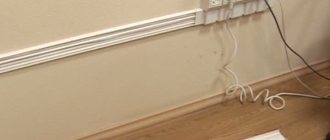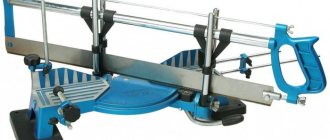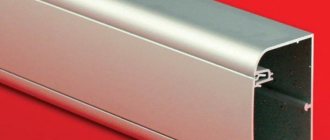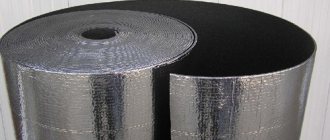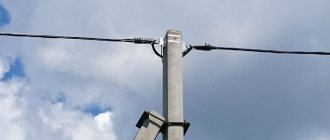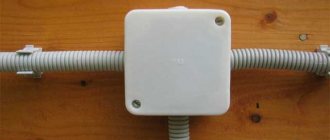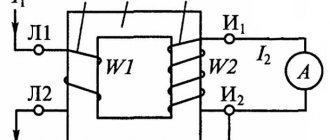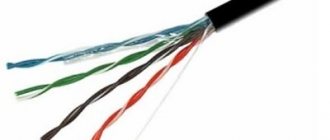What and how to buy for electrical wiring installation
Now that you know exactly what electrical devices and accessories you will need, how many corners and turns you plan, how many meters of electrical wires and cable channels will be required for installation, you can go to the store. When buying, take extra of everything.
- Take 4-5 meters more cable boxes and electrical wires;
- Accessories - 2-3 pieces each;
- Sockets and switches - 1-2.
Surely, when creating the project, you missed something or miscalculated. It is possible that errors may occur during operation, which will lead to damage to the device. Having extra parts will save you from unnecessary trips to the store. In the store, check each part for integrity, so that all elements are free of cracks and dents, and the lids on the boxes should hold
It is important. If you feel that the cover does not snap well or does not adhere well to the profile, request replacement. Important: when choosing electrical devices and wires, do not save
Choose only certified quality products. The fire safety of the apartment and the safety of family members depend on this. Experienced electricians prefer copper wires. Important: It is prohibited to connect aluminum and copper wires together in one twist. Firstly, such a connection is fraught with electrolysis, and secondly, the wires have different linear expansion when heated, which is possible when a current of more than 800 volts passes. As a result, the contacts will weaken, which leads to even greater heating. And this is fraught with burnout of insulation, short circuit and fire. When calculating sockets, take into account the number of constantly operating electrical household appliances. For devices that consume electricity more than 1000 W, it is recommended to install a separate outlet with a separate wire. For low-current electrical appliances, you can choose a unit connected by one pair of wires and consisting of 3-5 sockets. Along with the fittings, you also need to buy fastening elements:
- Liquid nails, screws with or without plastic dowels;
- Wire connectors – terminal blocks, caps, sleeves;
- Insulating tape.
Installation of cable boxes begins from the distribution board (box), which is usually located at the entrance to the house. The counter is also installed here. From here the wires branch out and run throughout the house. Therefore, it is advisable to connect larger boxes to the distribution board than those that will be installed in the rooms. And a residual current device (RCD) must be installed in the switchboard.
A few installation recommendations
The procedure and features of installation of electrical boxes depend on the presence of shaped elements in the design. If there are any, the manufacturer usually provides recommendations on the optimal location and required location for installation. To get the best results, it is recommended to adhere to these rules.
When installing a decorative cable channel for external wiring, you must first draw its location on the wall and calculate in advance a convenient height for placing sockets, switches and other elements. And to make sure that the line is even, it is better to check with a building level. Next, the box itself is installed. For a smooth and even wall, you can use hot melt adhesive. If the wall is uneven, then it is best to use dowels or screws, depending on the type of surface. Decorative boxes can be mounted on a low-flammable or non-flammable base. This could be a drywall, concrete, plaster or brick wall.
The decorative cable channel consists of a base and a cover. The number of wires in a cable channel is not standardized. Enough for the lid to close easily. But in some situations there are restrictions. For example, for separate placement of power and low-current cables, a small gap is required, so it is important to choose the correct size of their cross-section.
When choosing the optimal cross-section size, you need to focus on the purpose. Therefore, it is recommended to add 4-5 mm to this figure. Such a reserve will not only prevent the entire system from catching fire in the event of a short circuit, but also provides additional space for laying another wire or replacing (repairing) existing cables.
Installation of open wiring
Electrical wiring can be hidden or open
Electrical wiring methods are related to the type of its placement.
The device of a hidden type of electrical wiring involves the installation of special grooves (grooves) in the structures of walls and ceilings for placing electrical cables in them. This type of electrical wiring device actually turns into a major overhaul of the entire building or room. There is a need to cut the walls with a grinder, as a result of which dust appears; in the future, it is necessary to plaster all the places where electrical wires are sealed and reapply the coating (for example, paint, glue wallpaper, etc.). During the period of electrical wiring replacement, the premises actually become unsuitable for work or stay.
Features of open wiring with CC
Open wiring using electrical boxes tempts with ease of installation, repair and simplicity of carrying out an ongoing audit of the condition of cable lines inside the CC.
Note! Installation of hidden wiring is inherently comparable to the overhaul of the entire room. During the replacement of hidden wiring elements, the room is virtually unsuitable for work or even staying in it due to clouds of dust formed when previously sealed grooves are opened.
The industry produces sets of accessories for CC, with the help of which an external type cable route is mounted, duplicating the outlines of the walls, floor and ceiling of the room.
Selection of electrical cable cross-sections
The cross-section of electrical cables is selected based on the power of existing electrical energy consumers. It is especially worth highlighting the following requirements for selecting the cross-sectional area of electrical cables:
- for lighting devices, it is necessary to use an electrical cable with a cross-sectional area of approximately 1.5 square meters. mm;
- for sockets it is necessary to use an electrical cable having a cross-sectional area of approximately 2.5 square meters. mm.
- for energy consumers with increased power (for example, an electric furnace), it is more correct to use an electrical cable with a large margin for the passage of electric current - 4 kW. mm.
The most complete and detailed information on the requirements for selecting cross-sectional area and the brands of electrical cables used can be obtained from the regulatory technical base.
It is also worth noting that an increase in the cross-sectional area of an electrical cable affects an increase in its cost, thus, the “more, just in case of fire” approach often used by consumers is meaningless. Organization of electrical wiring in the baseboard space.
The arrangement of electrical cables in baseboards has a certain disadvantage, namely that the small volume of the cable channel inside the baseboard is not enough to accommodate more than three electrical wires of average diameter, although in most cases this volume is more than enough. Otherwise, laying wiring in skirting boards is very convenient, and the room is less cluttered with various structures, while maintaining its original design and concept.
Where to buy cable channels for electrical wiring: types, manufacturers and prices
You need to understand the manufacturers of such products if you want to buy cable channels for your home. Many companies offer high quality boxes
In such a situation, it is important to distinguish a fake. You need to ask the consultant for the necessary documents for the products
Let's take a look at some branded manufacturers:
- Hager. The German manufacturer specializes in office products, but due to the high quality of the boxes, they are also used in residential areas. The products are made in a modern design and are suitable for many interiors. The tehalit.BRP series is used for laying main lines. Universal models are boxes of the tehalit.LFF series, which are characterized by simple installation;
- Legrand. The company offers profiles in different sizes and widths up to 220 mm. There can be up to three sections inside the housing. The cable channel is equipped with two types of partitions. Some are mounted in a special groove, while others are flexible and glued to the wall.
- DKS. This domestic manufacturer produces 4 types of channels. Wall-mounted ones have a flat lid and are compact in size. Floor boxes are equipped with turns. They are easily connected to each other. The mini channels come in dark brown and white;
- Schneider Electric. The manufacturer offers the Ultra series with two types of channels. Switches and sockets are mounted in modular frames. Mini channels have a U-shaped cover. For quick installation, you can choose products with self-adhesive tape.
We suggest looking at some types, sizes and prices of cable channels in our table.
Table 1. Average cost of cable channels
| Photo | Model | Description | Price, rub/linear meter |
| Elekor 2m IEK white | Suitable for low-current, information and power communications in offices and residential premises. | 36 | |
| Ruvinil PKK 16×16×0.8 m | The texture of the material is wood, the color is oak. The material used is self-extinguishing polyvinyl chloride. | 76 | |
| Cable channel 25-25 mm. Mutlusan (pack of 100 m) | The material is made to look like light wood. | 2007 (per package) | |
| Cable channel 20×10 mm (160 meters per package) T.Plast | Product material is white plastic. | 1390 (per package) | |
| Hager LFF channel 60×110 | The structure is made of white plastic. | 422 | |
| Legrand DLP with flexible cover 105×50 | Material white PVC. | 695 | |
| Perforated DKC 25x40, 2 meters. | The design has a corrugated structure. Made of high quality plastic. | 456 |
Elekor 2m IEK white Cable channel 25-25 mm Mutlusan packaging 100 m Cable channel 20×10 mm T.Plast Legrand DLP with flexible cover 105×50 Perforated DKC 25×40
Types and sizes
Types of cable channels differ from each other mainly in shape, only some use special materials - for example, transparent plastic or aluminum and its alloys.
There are different models for different occasions
Skirting cable channels
If you want to covertly lay cables without having to dig into the walls, take a closer look at plinth cable channels. These are a kind of plastic plinths, in the internal cavities of which wires are laid. They are available in different colors and will suit different decor styles.
Plastic cable channels of plinth type
Manufacturers of entire systems of plinth cable channels, in addition to long trays, produce a number of additional devices that allow the construction of any shape. These are external and internal corners, bends of various shapes, plugs, mounting and multi-module boxes on which switches and sockets can be installed.
There is also an option to install sockets directly at the baseboard level. For older people, this option is not the best, and for young people, low slopes are not a problem. But it doesn't attract as much attention.
The socket can be installed directly at the baseboard level
This type of cable channels is available in different color variations - from white, gray and black to colors that imitate wood and metal surfaces. The disadvantage is the rather high price, although it cannot be compared with the payment for wall gating.
Available sizes of SL Hager products are 20*50 mm, 20*70 mm, 15*100 mm, 25*100 mm. The Legrand company has two series: mini with dimensions - 20*12.5 mm, 32*12.5 mm, 40*12.5 mm, 32*16 mm, 40*16 mm, 60*60 mm, 60 *20 mm, 75*20 mm. The second series - DPL has the following dimensions: 35*80 mm, 35*105 mm, 50*80 mm, 50*105 mm, 50*150 mm, 65*150 mm. Another video about another system of baseboard cable channels.
p;
Floor-standing
This type of cable ducts also differs in shape and installation method. It is installed on the floor, so on one side it has a rounded shape, so it does not interfere with movement. Available in impact-resistant plastic or aluminum. The shape is the same.
Floor cable channels do not interfere with movement
Floor cable trays are used as part of a system - when you need to route wiring to a table or lighting fixture that is located far from the walls. It successfully replaces carriers and extension cords.
How are the dimensions of floor cable ducts determined?
The following sizes are available for sale:
- 50*12 mm;
- 75*17 mm;
- 92*20 mm;
- 160*65 mm;
The color scheme is not very diverse: usually there are gray, white and black. The joints of two strips, corners and turns can be designed using shaped products of a suitable size. First, the lower part is mounted, the conductors are laid, after which the cover is snapped on.
Rules for installing floor cable channels from Legrand
Then accessories are installed in the right places - corners, joints. They are made in such a way that they simply snap into place, providing a secure fit. At the same time, the degree of protection is even maintained (usually IP40).
Parapet
Parapet cable channels (also called main cable channels) are similar in structure to plinth ones. They differ slightly in shape, but mainly in that they are mounted above floor level. They also consist of various elements that allow you to assemble any configuration.
Parapet plastic cable trays
Mainly used in offices or factories. If such structures are installed in private houses or apartments, they try to match the color of the wall decoration. The routes connecting the external and internal units of air conditioners are usually closed.
Dimensions can be:
- width 80 mm, 100 mm, 120 mm, 150 mm;
- height 40 mm, 55 mm, 60 mm.
For each type of section there is a set of shaped elements - external and internal corners, plugs, splitters, etc. There may be several colors, but the main ones are white and milky. The rest are quite hard to find.
Mini
A smaller version of parapet cable channels, into which a certain number of conductors can be laid - television, telephone, for the Internet.
Such options are used more often in apartments and houses
When using this product, the corners are formed not with special shaped parts, but by sawing the box at the desired angle (usually 45°, only taking into account whether it is internal or external).
Dimensions can be:
- width 10 mm, 12 mm, 16 mm, 20 mm, 25 mm, 40 mm, 60 mm, 80 mm, 100 mm.
- height - 10 mm, 12 mm, 16 mm, 20 mm, 25 mm, 40 mm, 60 mm.
Combinations of these sizes provide a large number of options. There are wide and low, there are narrow and high, so there is a choice and you can choose it.
Corner
Due to their design, corner cable ducts can be installed at the junction of the wall and ceiling or instead of a baseboard. If the corners are carefully executed (they must also be cut with a hacksaw at the desired angle), they look like a decorative element.
This type of cable ducts are mounted in corners - at the junction of the ceiling and wall
The disadvantage is that they do not have as much space as baseboards, and the walls are thinner, so there is a high probability of damage when laying underneath. The most common sizes are 40*40 mm, so you can’t fit a lot of cables in them.
For LED strips
This is a type of corner version of cable trays. They differ in that the lid is made of transparent or translucent plastic.
Some types of trays for LED strips
Mounted under the ceiling in corners, on the bottom panel of kitchen cabinets or in the cabinets and cupboards themselves. They don’t have wiring installed, so the organization of the internal space is completely different - they make a platform on which it is convenient to attach a strip of LEDs. Its position is selected based on the required direction of the light flux.
Metal trays for cable laying
This type of product in private homes is used mainly for laying wiring in combustible walls - during the construction of frame or panel houses. Trays are placed inside the wall and ceiling, cables are pulled into them, and in the right places they are led out through the wall or ceiling cladding.
Examples of metal trays: solid, perforated, wire
Also, some types (wire cable channels) are used for lighting a stretch or suspended ceiling. With their use, installation time is sharply reduced, because instead of installing a large number of small fasteners, you need to attach several hangers for trays, and then lay all the cables in them.
Dimensions of metal cable trays:
- width from 50 mm, 80 mm, 100 mm, 150 mm, 200 mm and further up to 600 mm in increments of 100 mm;
- height - 50 mm, 80 mm, 100 mm;
- the length of one piece is 3m.
So you can choose one for any number of conductors.
Place of installation - floor, partition, ceiling
Separately, it should be noted the options when hidden electrical wiring is installed in floors, ceilings or partitions. For example, if we are talking about a suspended ceiling made of plasterboard with a metal frame, then it will be much easier to hide the wiring; you don’t even need to ditch the walls - the conductors are simply hidden under the ceiling, and go down at the right points.
You can also place junction boxes under the drywall, but for them you will have to worry about installing hatches opposite. Hatches are used to gain access to hidden wiring if necessary. Clamps or UW are used to secure lighting cables to the ceiling covering.
The best option: hidden electrical wiring is first hidden in pipes, and they are already mounted in the ceiling. This solution makes it possible to increase the fire safety of a plasterboard structure; installation is carried out using clips.
Installation of hidden electrical wiring under the floor covering is carried out in a similar way. The easiest way to install cables in the floor is if it is made of wood or gypsum fiber. In the case of wood, holes are made in the logs into which pipes are inserted and the cable is laid accordingly. As an alternative, hidden wiring can be arranged along the floor surface. First, level the surface with expanded clay or a similar mixture, and apply a finishing coating on top.
Some install hidden electrical wiring in the apartment, hiding the wires in pipes and then filling them with cement. This should not be done, especially if it is planned that the layer of solution above the pipe will be small.
An important point: if you decide to hide the wiring under the floor or ceiling, connections may only be made in specially designed boxes. This is the only way, if it fails, it will be possible to get to it relatively quickly.
Often, hidden wiring is installed behind drywall and into partitions.
In an attempt to get by with minimal effort, holes are made in the metal profile itself. You should also not pull wires through the drywall before sewing it on. In both cases there is a high risk of damage to the insulation. Pulling out the conductor for repair becomes very problematic. This problem can be solved simply. Before pulling the conductors through the holes, you should first put them in pipes.
Working with lighting is much easier. The key role here is played by voids in the slabs. They remain from the floor installation stage. This solution is also attractive because it does not require any gating. However, this does not affect the protection of the cables. It is enough to punch two holes: at the wall and at the location of the lamp. To pull wire through pipes, special probes made of rigid wire are most often used.
It remains to note the case when hidden wiring is installed through insulation in the walls. It is preferable to lay through mineral wool due to the individual characteristics of the material: it is lightweight, has excellent compressibility and does not require any additional work. Many people prefer polystyrene foam, but additional channels for pipes will have to be cut into it.
General information
There are two ways to lay the wire:
- open method;
- closed or hidden method;
With an open installation method, there is no need to hide the cable in the wall. It is either laid on cable trays, pulled into a corrugated pipe, or mounted using cable channels (ducts). This method is practical in maintenance; there is always access to the wires and the ability to check the condition of the wiring.
With the closed method, the cable is also laid using boxes, corrugated pipes or trays, but at the final stage all wiring is hidden in the wall or under the ceilings. Due to the lack of free access, it is difficult to maintain cable networks.
Important! Cable trays are often used in technical rooms - plinths, basements. Laying of electrical networks in accordance with SNiP 3.05.06-85 is carried out in bulk, in bundles, in multi-layers.
Installation of cables and wires using corrugated pipes is usually carried out in damp rooms, basements, living rooms, and underground. It is important to remember that it is prohibited to use metal corrugated pipe underground due to its ability to corrode. In addition, it is not recommended to use black corrugation during installation, as it is susceptible to burning. The standard color for residential use is grey. It belongs to the NG group - non-flammable. Boxes and cable ducts are used in residential premises, offices, and technical rooms.
Materials for cable channels
Wire boxes are often made of metal or plastic. Plastic is a more budget option. Structures made from it are not particularly durable, so they are used for ceilings and walls. Such guides must be non-flammable and not emit a lot of smoke.
Durable metal structures are suitable for rooms with a high risk of fire
Metal elements are of higher quality. Channels made of galvanized steel and aluminum can withstand significant loads.
The designs of cable channels for electrical wiring are as follows:
Perforated steel lines are often used in production
Anodized aluminum baseboards are durable
A box made of fireproof plastic is in demand for any premises
In rooms with a high risk of fire, it is recommended to install metal ducts. They are used in factories and workshops.
In the video you can see how cable channels are attached and used:
Metal boxes for laying cables: characteristics of materials
A metal wiring box has many advantages. Here are some of them:
- protection against mechanical and electromagnetic influences;
- ease of installation work;
- excellent level of fire safety;
- various color solutions;
- cover with a latch.
Metal boxes are in demand in rooms with special conditions
Elements of metal boxes for electrical wiring:
- 90 degree angle for turning upward;
- outer corner for turning down;
- flat goal 90 degrees;
- T-piece;
- X – shaped section.
Cable channels in the form of metal pipes are used for wall mounting
Industrial plants often use anodized aluminum boxes. They are used for installation in open wiring.
The following advantages can be noted in a steel electrical box:
- increased level of impact resistance;
- protection against electromagnetic influence;
- resistance to sunlight;
- resistance to temperature changes.
Choosing a plastic box for wires: degree of rigidity and other characteristics
Common options include plastic boxes for electrical wiring. This option is a closed type design. The cross-section and box can be any: square, rectangular or triangular. Sizes and color palette may also vary.
Before installation, plastic structures often require sawing
It is worth highlighting the following advantages of the plastic cable channel:
- light weight;
- corrosion resistance;
- simple fastening system;
- the cover is mounted without any tools;
- PVC cable channel has a low cost;
- the ability to cut an element to the required length;
- high decorative properties;
- ease of care;
- there is no deformation due to temperature changes.
Plastic cable ducts, their advantages
Plastic products are considered a budget option and, compared to their metal counterparts, are less durable. Therefore, use as a supporting structure must be extremely careful and balanced. PVC boxes are made from polyvinyl chloride (PVC plastic) using special additives (for example, fire retardants). They give the cable channel the necessary plasticity, reduce smoke formation and do not support combustion.
Plastic cable ducts come in open and closed types. An open box is used for electrical wiring in industries with a small number of cables. Closed PVC boxes are often installed in household electrical wiring. They have an aesthetic appearance, various shapes and many colors.
Advantages of plastic boxes:
- the flexibility of the parts allows them to fit tightly to the surface, thus hiding various irregularities;
- do not require corrosion protection;
- have a low weight, which facilitates transportation, unloading - loading and other work;
- creates additional insulation, as it does not conduct electric current;
- using lamination, a reliable imitation of wood, stone, metal is created;
- you can easily make a hole in the right places;
- the possibility of repeated installation and dismantling without causing any damage thanks to the snap-on lid;
- using various pigments, a wide palette of colors is obtained;
- the ability to create products of complex shapes (for example, to solve a design idea) using extrusion technology.
Wire quality
It is worth remembering that the reliability of hidden, and indeed any, wiring depends not least on the quality of the wire. Today you can find a large assortment of conductors on the market. Their main parameters are as follows:
- the cross-sectional diameter of the core can be from 800 to 0.75 mm;
- core material (most often copper, aluminum or their alloy);
- number of cores up to 37;
- wire sheath: yarn, rubber, paper, plastic (more protected wires have two types of insulation).
For installation of wiring at home, cables marked NUM and VVG are used, as well as wires SHVVP, PUNP and a number of others. It is worth briefly talking about the main features.
VVG is a cable without armor, the cores of which are copper and the insulation is vinyl. There are several varieties on the market with additional markings: VVG NG has increased fire safety, VVG Z has additional insulation, etc.
NUM is a high-strength cable for organizing hidden wiring. Poorly suited for outdoor wiring, since the outer shell has poor resistance to sunlight.
PVS – connecting wire for any type of work.
PBGPP and PBPP – wires for laying lighting lines. They differ in the presence of an additional flexible core.
ShVPP is a copper wire of increased flexibility.
In general, making hidden wiring at home with your own hands is a difficult task, but quite accessible even to a non-specialist. The main thing here is to strictly observe the technology features and nuances described above, and then high-quality wiring will delight you for many years.
Method No. 2 – Dowel-nails
If you need to attach a cable channel to a concrete or brick wall, which is a typical situation for an apartment or a house, you cannot do without dowel nails, also called “quick installation”. In addition, for fastening you will need a hammer drill with a 6 mm drill. So, in order to independently fix the electrical box for the cable on a wall made of concrete or brick, you need to perform the following steps:
- Pre-drill 6 mm holes in the bottom of the cable channel every 40-50 cm.
- Attach the box to the wall according to the markings (more on this later) and mark the drilling points that coincide with the finished holes in the cable channel.
- Drill holes according to the marks on the wall.
- Place the plastic box and drive the dowels into the appropriate places.
- Hammer the nails.
Using these simple instructions, you can install the cable duct yourself in a wall made of concrete or brick
We draw your attention to one very important point - you should not drill holes with a drill while leaning the box against the wall. When drilling plastic, the impact mode can cause cracks to appear, which can have a negative impact both visually and on the durability of the finished wiring.
Detailed video instructions for installation work
How to connect an Internet cable to an outlet: pinout diagram and instructions
Today in this article we will look at three types of sockets for an Internet cable. I’ll tell you how to crimp each one on the go when you don’t have enough tools. And also which outlet is better to choose for home use and connection. I hope you have already installed the cable. Next, the wires usually go into special mounting boxes if you are going to use internal sockets. Or they are laid separately in cable ducts in an external socket (“Box” type).
Try to leave as much wire as possible, preferably from 15-20 cm. Just in case you have to re-crimp the wires
Now let's turn our attention to the pinout or crimp color that currently exists
There are two types of them “A” and “B”. If anyone has ever crimped wires, then they know that it is the “A” system that is used for crimping cables. But for sockets it is the “B” scheme that is used. And we will use it exactly. Now I will tell you how to connect an Internet cable to an outlet using the example of different models.
Replacing wiring in an old apartment
Almost the same picture emerges when it is necessary to carry out major repairs in an old apartment. In addition to all finishing work, replace old wiring with new wiring connected to modern sockets and switches.
But, if finishing the finishing yourself does not seem to be a particularly difficult task, then how to change the old wiring with your own hands without having the appropriate knowledge? Hard to imagine.
Work related to electricity has an increased degree of accuracy and if a mistake is made, this can lead not only to the stoppage of vital activities in the apartment (turning on the lights, operation of electrical appliances and various equipment), but also create risks for human life. This means you either need to be a specialist yourself, or invite qualified electricians.
You should not rely on your own strength and consider yourself a knowledgeable person in this area, just by watching a couple of educational videos on the Internet. This is not the case. Everything is much more serious here.
Box vs groove
First, let's find out why a plastic wire box is more convenient than hidden wiring in grooves and in what ways it is inferior to it.
Advantages
- The minimum amount of dirty work and the complete absence of so-called “wet” work (associated with the use of building mortars). All you need to do is drill a series of holes to attach the cable ducts;
- Extremely simple connection of new sockets. If you need to install a new stationary electrical appliance in the room, there is also no problem: just open the box, strip the insulation and install a couple of terminals for the wires;
Need another outlet? No problem!
- You will never hit a wire with a drill during repairs. At the same time, you do not need to keep a wiring drawing indicating all the distances: it is right in front of your eyes, in the box;
- Repairing or replacing a section of wiring will also not cause any problems. You don’t have to re-drill the walls and seal the grooves with putty: just open the plastic boxes intended for wires.
Flaws
The boxes are forced to use only overhead sockets, which is not always convenient;
Surface-mounted sockets and switches are used with open wiring
Strobes benefit from an aesthetic point of view: the surface of the walls is not decorated with dubious decorative elements;
The material of the main wall provides effective heat removal
The video attached to the article will help you learn more about the features of their use for wiring.
Methods of using cable channels for laying open electrical wiring
A wide range of components for electrical wiring allows you to implement the most complex projects. Installation of the wall box is carried out taking into account the height of the sockets, junction boxes and switches. For open spaces, designs of wall and floor cable ducts made of metal are used. This provides protection from the effects of electromagnetic vibrations. Such options are relevant when installing information wiring.
Before proceeding with installation, it is worth understanding the basic elements of the electrical wiring diagram.
An angular cable channel is used for mounting the backlight of LED strips. Most often, such products are made of aluminum, and the lid is made of heat-resistant plastic.
Corner cable channel is used to fill the junction of the main line in the corners
For the home, a flexible cable channel for wires is often used. Lightweight metal models are also used. There must be enough space inside the case for a certain number of cables
It is important to check the availability of the necessary accessories for the cable products
Flexible designs allow you to disguise a large number of wires
When choosing products, you need to count all the locks, mounting fasteners and plugs on the spot.
Electrical wiring can be organized according to an open circuit using the following types of electrical boxes:
Wall Channel Installation
- floor plinth with separate sections for low-current wires;
- ceiling material;
- designs of cable ducts on the floor with protection from mechanical impact;
- corrugated pipes and trays used in utility rooms or for external facades.
Related article:
Outdoor cable channels are used for the local area.
Flexible structures can be used for outdoor use
Installation of wall boxes is carried out using self-tapping screws. They should be installed at certain intervals. The load is determined by the number of wires inside. To fix it on a wooden surface or on drywall, it is necessary to screw it in every 40-50 cm. If the walls are uneven, then the distance may be less to hide flaws.
To work with a brick or concrete wall, installation is carried out using dowels. To work, you will need a hammer drill with a nozzle with a diameter of 6 mm. The simplest fastening option is liquid nails, which are construction adhesive.
Wall mounting option
Floor channels will allow you to disguise any wiring so as not to spoil the interior. In this case, the structure is combined with the baseboard. Before installation, markings should be made on the walls and floor. Interestingly, plastic cable channels are mounted not to the floor, but to the wall. Installation is carried out using screws, liquid nails and dowels.
Installation of a floor skirting box
Installation of wiring in the channels is carried out after completion of finishing work. Markings for the cable mesh are marked on the walls. Laying is done from the distribution panel. First of all, main lines are installed, and then branches from them. If the channels do not have holes, you can make them yourself.
Installing a wall channel with wires
The channel section is fixed to the wall. In this case, the line should be positioned in the center of the holes. After this, fastening with dowels is carried out. After installing the connecting parts, the box is cut to the required length.
The features of installing a cable in a box are shown in the video:
How to choose?
First of all, you need to focus on the interior. The purpose is also important. For example, a plastic box is best suited for wiring electrical and communication cables. Wires made of steel and aluminum are used to install cables for video surveillance or security alarm systems.
The plastic cable channel is easy to install and process. It is best to hide the wiring in a plastic box with a lid that snaps on both sides. It is better to purchase a cable channel with thick walls - it lasts much longer than the thin-walled version.
In addition, there are differences in color. For offices and ceilings, a classic white box is most often purchased. Decorative wood-look cable channels are usually used for floors, and colored cable channels are used for walls.
And one more important point is the number of wires that fit in the box. You need to know this figure before purchasing.
Decorative cable channels several meters long are sold. They can be cut, joined at an angle or joined. This will not affect the cable protection in any way.
If there are no special fire safety requirements in the room, then the use of flammable materials is available. If mechanical loads are provided (for example, a floor), then preference should be given to high-strength materials.
Manufacturers offer a wide selection of cable channels, varying in shape and size. When purchasing a product, you should rely on your own needs. But to make the choice easier, it is better to make a list of requirements in advance. It is important to consider the following criteria:
- size of cables and wires;
- aesthetic data;
- possibility of modernization;
- the need for additional protection;
- characteristics of the equipment that will be connected;
- nuances of laying the route.
Open type electrical wiring in hard-to-reach and difficult places
Doors and interior partitions are considered hard-to-reach or difficult places to install open wiring. In such a partition for installing a cable channel, it is necessary to create a special hole for inserting a plastic tube of the required diameter. Then the electrical cables are placed directly in this plastic tube. If the electrical cable is laid at the bottom of the room along a wall that has a doorway, then it is necessary to run the electrical cables around or over the doorway. In accordance with the electrical installation rules, it is not allowed to lay an electrical cable under laminate or linoleum in such an area. Where the door opening is installed, local built-in electrical wiring must be used, i.e. make a special groove in the floor screed, lay protection for the electrical cable in this place, and lay the electrical cable directly through the installed protection.
Hiding the wires in a box
If, after all, ditching a wall is too radical a way for you to solve the problem of wires getting tangled and interfering with comfortable viewing, then this option can confidently be called a compromise. First, let’s talk about all the advantages of using it.
- extremely simple installation;
- magnificent aesthetic appearance;
- compliance with all fire safety standards.
Let's touch on the cons:
- the cost of purchasing a decorative box or cable duct;
- the need to make holes in the wall.
, and a full-fledged decorative
box
. The photo below demonstrates the difference between these two elements.
The basic material from which the box can be made is:
- plastic;
- metal.
However, combined options using two of these materials are also often found.
What will be the procedure?
- calculate the required amount of material, taking into account the direction of the wires and the size of the room;
- fix the box on the wall, make the necessary cuts in corners and transitions;
- keep in mind that the wire should lie freely in the box, so select the appropriate channel for it in diameter;
- After installation is complete, you can repaint the cable channel or box in accordance with your preferences or interior design logic.
The whole process is on video
You can do without painting, and simply select in advance a box of a suitable color design with the wall. Fortunately, the choice in construction stores is now more than wide and can satisfy even the most extravagant requests.
What are the types of cable channels for electrical wiring: what is it?
A cable duct is a metal or plastic box for electrical wiring that can be used indoors and outdoors. The design consists of a body and a cover. Most often they have a square or rectangular cross-section. The body can be perforated or solid. The body part and the cover are connected using a special lock.
Plastic structures that can look like skirting boards are popular
Cable boxes are mounted in different systems. They come in a variety of colors and are highly aesthetic. The internal space can be divided by partitions. This allows you to separate low-current and power cables, which are laid separately
When choosing plastic products, you should pay attention to the non-flammability of the material.
Using a wood channel instead of a plinth
There are different types of cable channels:
Miniature channels can be made of metal or plastic
Parapet products are perfectly fixed to the wall
Option for plinth with installation of wires
Flexible products are often used in office premises for cable routing in difficult areas
There may be several partitions inside the corner housing
Floor channels are complemented by inserts for switches
Channels with LEDs can be located in baseboards
How to choose the right cable channel can be seen in the video:
When choosing products, you need to pay attention to GOST standards for cable channels. The possibility of installation depends on the degree of flexibility and rigidity
Rigid structures can be in the form of boxes with holes or blind boxes. Flexible cable channels are represented by corrugated pipes, tracks and chains.
Corrugated lines make it easier to install wiring in hard-to-reach places
Typical sizes of decorative cable channels
The range of sizes and standards depend on the manufacturer. The price also depends on these parameters. The length of the boxes is standard - 2 m. But the cross-section can be different. The most commonly used products are 12*12, 40*40 and 100*60 mm.
For standard length, the section dimensions can be as follows (in mm):
- 12*12;
- 15*10;
- 16*16;
- 20*10;
- 25*25;
- 30*10;
- 40*40;
- 60*60;
- 80*60;
- 100*60;
- 150*100.
For laying communication cables, a box with a cross section of 12*12 mm is usually used. The most popular corner option is 40*40 mm.
When choosing a size, it is important to consider the fact that the lock should open and close easily. In addition, there should be a small amount of free space inside. To connect the planks to each other, special adapters are used. In addition, each profile has holes for mounting to a wall or other surface. The hole pitch is 0.5 m.
How to check the quality of a cable channel
When choosing a cable channel, pay attention to the quality of casting and plastic. The walls should not be very thin, the tray should be rigid and hold its shape well
The second thing you need to pay attention to is the lock and how well it closes. These locks come in different designs.
The simplest ones are single ones. They are easy to install and remove, but with a lot of cables there is not always a way to keep them in place.
One of the important criteria is the type of castle
A double lock is more reliable, but is harder to close/open. In warm weather it can be easier to handle - the plastic is more elastic. In a cold room this can be problematic. However, they try to use double locks, as they are more reliable.
You can check the quality of the cable channel by opening/closing the cover a couple of times. If there are no cracks/damages, the product is normal.
What are extras
The cable boxes are supplied with so-called accessories:
- Couplings, or connecting connectors, are installed at the junction of two boxes if the wiring length exceeds the standard 2 meters for a box. If, for example, the length of the wiring in a visible place is 3 or 5 meters, the craftsmen trim the cable channels so that the couplings are located symmetrically. In the first case, they make not 2 and 1 meter, but 1.5 and 1.5;
- A T-shaped coupling (corner) connects 3 boxes having a T-shaped joint;
- Triangles (external and internal) are used to connect two boxes in the corner. These elements are able to change the angle from 70 to 130, providing close contact with walls that have non-standard architecture. External triangles are used to connect boxes on wall ledges, internal triangles are used to connect the channel cable from the wall to the ceiling or when turning along the internal perimeter of the room;
- Plugs are used to close the box at the end of the pencil case;
- The installation box is intended for installing switches and sockets.
The extensions are matched to the tone of the main boxes, which can be cut together with the covers:
- Plastic - with a carpenter's hacksaw with fine teeth;
- Aluminum and steel profiles - with a grinder or a hacksaw.
To maintain the correct angle during the cutting process, you can use a carpentry tool - a miter box.

